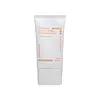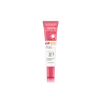What's inside
What's inside
 Key Ingredients
Key Ingredients

 Benefits
Benefits

 Concerns
Concerns

 Ingredients Side-by-side
Ingredients Side-by-side

Water
Skin ConditioningZinc Oxide
Cosmetic ColorantPropylheptyl Caprylate
EmollientDibutyl Adipate
EmollientButylene Glycol
HumectantDisiloxane
Skin ConditioningCyclohexasiloxane
EmollientPolyglyceryl-5 Polyricinoleate
EmulsifyingPolymethylsilsesquioxane
Glycerin
HumectantBis-Ethylhexyloxyphenol Methoxyphenyl Triazine
Skin ConditioningCaprylyl Methicone
Skin ConditioningDicaprylyl Ether
EmollientDiethylamino Hydroxybenzoyl Hexyl Benzoate
UV FilterEthylhexyl Triazone
UV AbsorberTitanium Dioxide
Cosmetic ColorantDisteardimonium Hectorite
StabilisingMagnesium Sulfate
Calcium Aluminum Borosilicate
Triethoxycaprylylsilane
1,2-Hexanediol
Skin ConditioningPolyglyceryl-3 Polydimethylsiloxyethyl Dimethicone
Skin ConditioningParfum
MaskingVinyl Dimethicone/Methicone Silsesquioxane Crosspolymer
Caprylyl Glycol
EmollientGlyceryl Caprylate
EmollientEthylhexylglycerin
Skin ConditioningTocopherol
AntioxidantBiosaccharide Gum-1
HumectantOryza Sativa Bran Oil
EmollientBeta-Glucan
Skin ConditioningWater, Zinc Oxide, Propylheptyl Caprylate, Dibutyl Adipate, Butylene Glycol, Disiloxane, Cyclohexasiloxane, Polyglyceryl-5 Polyricinoleate, Polymethylsilsesquioxane, Glycerin, Bis-Ethylhexyloxyphenol Methoxyphenyl Triazine, Caprylyl Methicone, Dicaprylyl Ether, Diethylamino Hydroxybenzoyl Hexyl Benzoate, Ethylhexyl Triazone, Titanium Dioxide, Disteardimonium Hectorite, Magnesium Sulfate, Calcium Aluminum Borosilicate, Triethoxycaprylylsilane, 1,2-Hexanediol, Polyglyceryl-3 Polydimethylsiloxyethyl Dimethicone, Parfum, Vinyl Dimethicone/Methicone Silsesquioxane Crosspolymer, Caprylyl Glycol, Glyceryl Caprylate, Ethylhexylglycerin, Tocopherol, Biosaccharide Gum-1, Oryza Sativa Bran Oil, Beta-Glucan
1,2-Hexanediol
Skin ConditioningWater
Skin ConditioningArtemisia Capillaris Flower Extract
Skin ConditioningBifida Ferment Lysate
Skin ConditioningBiosaccharide Gum-1
HumectantBisabolol
MaskingButyloctyl Salicylate
Skin ConditioningCaprylhydroxamic Acid
Caprylyl Methicone
Skin ConditioningCetyl PEG/PPG-10/1 Dimethicone
EmulsifyingCitric Acid
BufferingCyclopentasiloxane
EmollientDimethicone
EmollientDisteardimonium Hectorite
StabilisingHexyl Laurate
EmollientMineral Salts
Skin ConditioningPhenoxyethanol
PreservativePolyglyceryl-4 Isostearate
EmulsifyingPolymethyl Methacrylate
Pongamol
MaskingPropanediol
SolventPropylene Carbonate
SolventSaccharide Isomerate
HumectantSilica
AbrasiveSodium Chloride
MaskingSodium Citrate
BufferingSorbitan Olivate
EmulsifyingTetrasodium EDTA
Titanium Dioxide
Cosmetic ColorantTriethoxycaprylylsilane
Zinc Oxide
Cosmetic Colorant1,2-Hexanediol, Water, Artemisia Capillaris Flower Extract, Bifida Ferment Lysate, Biosaccharide Gum-1, Bisabolol, Butyloctyl Salicylate, Caprylhydroxamic Acid, Caprylyl Methicone, Cetyl PEG/PPG-10/1 Dimethicone, Citric Acid, Cyclopentasiloxane, Dimethicone, Disteardimonium Hectorite, Hexyl Laurate, Mineral Salts, Phenoxyethanol, Polyglyceryl-4 Isostearate, Polymethyl Methacrylate, Pongamol, Propanediol, Propylene Carbonate, Saccharide Isomerate, Silica, Sodium Chloride, Sodium Citrate, Sorbitan Olivate, Tetrasodium EDTA, Titanium Dioxide, Triethoxycaprylylsilane, Zinc Oxide
 Reviews
Reviews

Ingredients Explained
These ingredients are found in both products.
Ingredients higher up in an ingredient list are typically present in a larger amount.
1,2-Hexanediol is a synthetic liquid and another multi-functional powerhouse.
It is a:
- Humectant, drawing moisture into the skin
- Emollient, helping to soften skin
- Solvent, dispersing and stabilizing formulas
- Preservative booster, enhancing the antimicrobial activity of other preservatives
Biosaccharide Gum-1 is a sugar created by fermenting sorbitol (which usually comes from potato starch!). It is known for its soothing and moisturizing properties.
Manufacturer tests show this ingredient helped reduce irritation from lactic acid by almost half and kept skin hydrated long-term as a humectant
Beyond hydration, Biosaccharide Gum-1 gives formulas a silky, non-sticky feel.
This ingredient is gentle, versatile, and suitable for all skin types.
Fun fact: Similar sugars can be found naturally in fruits like apples and pears.
Learn more about Biosaccharide Gum-1Caprylyl Methicone is a type of silicone.
It helps soften and soothe the skin by creating a thin film on top. This film helps trap moisture, keeping your skin hydrated.
Disteardimonium Hectorite comes from the clay mineral named hectorite. It is used to add thickness to a product.
It can also help stabilize a product by helping to disperse other ingredients.
Hectorite is a rare, white clay mineral.
Learn more about Disteardimonium HectoriteTitanium dioxide is a mineral UV filter widely used in sunscreens and cosmetics.
It is one of only two UV filters officially classified as “mineral” by regulatory agencies, the other being zinc oxide.
Titanium dioxide provides broad-spectrum protection mostly in the UVB and UVAII range, with some protection in the UVAI range.
While its UVA protection isn’t as strong as zinc oxide’s, the difference is minor.
A common myth is that mineral UV filters reflect UV light. However, modern research shows titanium dioxide absorbs UV radiation like chemical filters (~95% absorption & 5% reflection).
Thanks to its non-irritating nature, titanium dioxide is suitable for sensitive, acne-prone, or redness-prone skin. It is unlikely to cause "eye sting" like other sunscreen ingredients.
A major drawback of this ingredient is its white cast and thick texture. This is why mineral sunscreens often leave a white cast and are less cosmetically elegant than chemical/hybrid sunscreens.
To improve white cast and spreadability, micronized or nano-sized titanium dioxide is often used.
There are ongoing concerns surrounding nano-titanium oxide's impact on marine ecosystems.
There is no conclusive evidence that any form of titanium oxide (or any other sunscreen ingredients) will cause harm to marine ecosystems or coral reefs. The science is still developing but many consumers are keeping a close eye on this issue.
Please note, many destinations have reef-safety sunscreen rules. For instance, the U.S. Virgin Islands advises all visitors to use non-nano mineral sunscreens.
Nano mineral sunscreens once raised safety concerns about absorption into skin.
Extensive research has shown that they do not penetrate healthy or damaged skin; they remain safely on the surface and the top layer of dead skin (stratum corneum).
You'll likely find titanium dioxide bundled with alumina, silica, or dimethicone. These ingredients help make titanium dioxide highly photostable; this prevents it from interacting with other formula components under UV light.
Learn more about Titanium DioxideTriethoxycaprylylsilane is a silicone used to bind and stabilize ingredients.
As an emulsifier, it helps prevent ingredients from separating. This can help elongate the shelf life of products.
Triethoxycaprylylsilane is often used to coat mineral sunscreens ingredients to help give a better feel. It also helps reduce oxidative stress in sunscreens.
Learn more about TriethoxycaprylylsilaneWater. It's the most common cosmetic ingredient of all. You'll usually see it at the top of ingredient lists, meaning that it makes up the largest part of the product.
So why is it so popular? Water most often acts as a solvent - this means that it helps dissolve other ingredients into the formulation.
You'll also recognize water as that liquid we all need to stay alive. If you see this, drink a glass of water. Stay hydrated!
Learn more about WaterZinc Oxide is a mineral broad-spectrum UV filter; it is the broadest UVA and UVB reflector approved by the FDA. It also has skin protectant and skin soothing properties.
Zinc oxide is one of the most effective broad-spectrum UV filters. It protects against UVB, UVAII, and UVAI. In comparison to its counterpart titanium dioxide, zinc oxide provides uniform and extended UVA protection.
Another great benefit? This ingredient is highly photostable so it won't degrade easily under sunlight.
A common myth is that mineral UV filters are widely believed to primarily reflect UV light.
However, modern research shows titanium dioxide absorbs UV radiation like chemical filters (~95% absorption & 5% reflection).
Zinc oxide has great skin soothing properties so you'll likely find this in sunscreens formulated for sensitive skin or babies/children. It is unlikely to cause "eye sting" like other sunscreen ingredients.
Regulatory agencies consider zinc oxide to be non-toxic and safe. It has also been shown to not penetrate the skin.
Unfortunately, this ingredient does leave a visible white cast. This is why mineral sunscreens are often less cosmetically elegant than chemical or hybrid ones.
In cosmetics, zinc oxide can be found in both non-nano and nano-sized forms. The nano version is used to reduce white cast and improve the texture of sunscreen formulas.
There are ongoing concerns surrounding nano-zinc oxide's impact on marine ecosystems and whether it can be absorbed into skin.
Regarding marine ecosystems and coral reefs, there is no conclusive evidence that any form of zinc oxide (or any other sunscreen ingredients) will cause harm. The science is still developing but many consumers are keeping a close eye on this issue.
Please note, many destinations have reef-safety sunscreen rules. For instance, the U.S. Virgin Islands advises all visitors to use non-nano mineral sunscreens.
There has also been some stir about whether micronized or nano zinc oxide has potential photoxicity and absorption through the skin/lungs.
An in-vitro (done in a test tube or petri dish) study demonstrated micronized zinc oxide to have potential phototoxicity. There's no need to fret; the EU Commission's Scientific Committee on Consumer Safety has stated, "The relevance of these findings needs to be clarified by appropriate investigations in vivo." Or in other words, further studies done on living organisms are needed to prove this.
Current research shows zinc oxide nanoparticles do not penetrate intact or sunburned skin. They either remain on the surface or in the outermost layer of dead skin (stratum corneum).
Zinc oxide is one of only two classified mineral UV filters with titanium dioxide being the other one.
Fun fact: Zinc has been used throughout history as an ingredient in paint and medicine. An Indian text from 500BC is believed to list zinc oxide as a salve for open wound. The Ancient Greek physician Dioscorides has also mentioned the use of zinc as an ointment in 1AD.
Learn more about Zinc Oxide